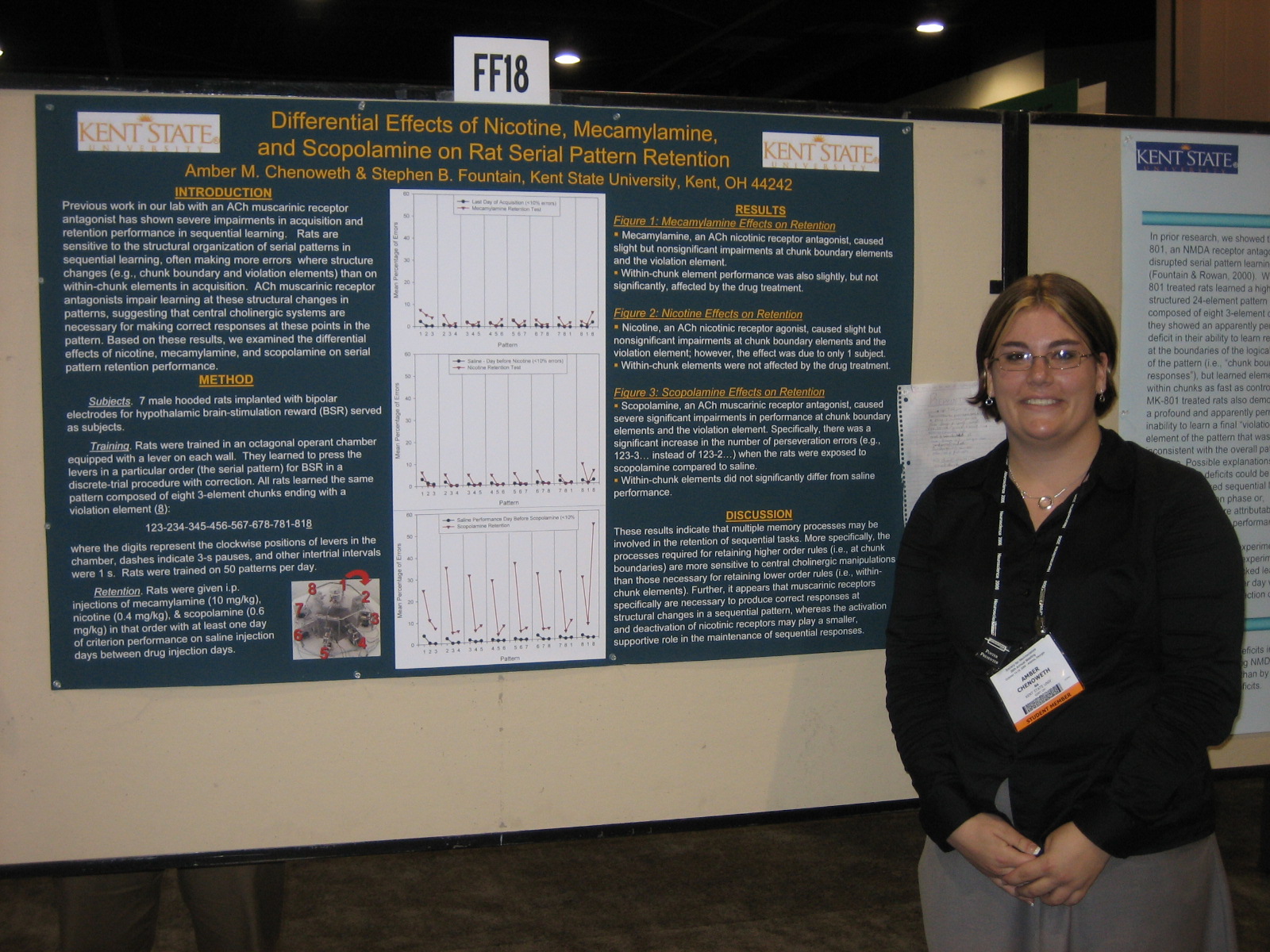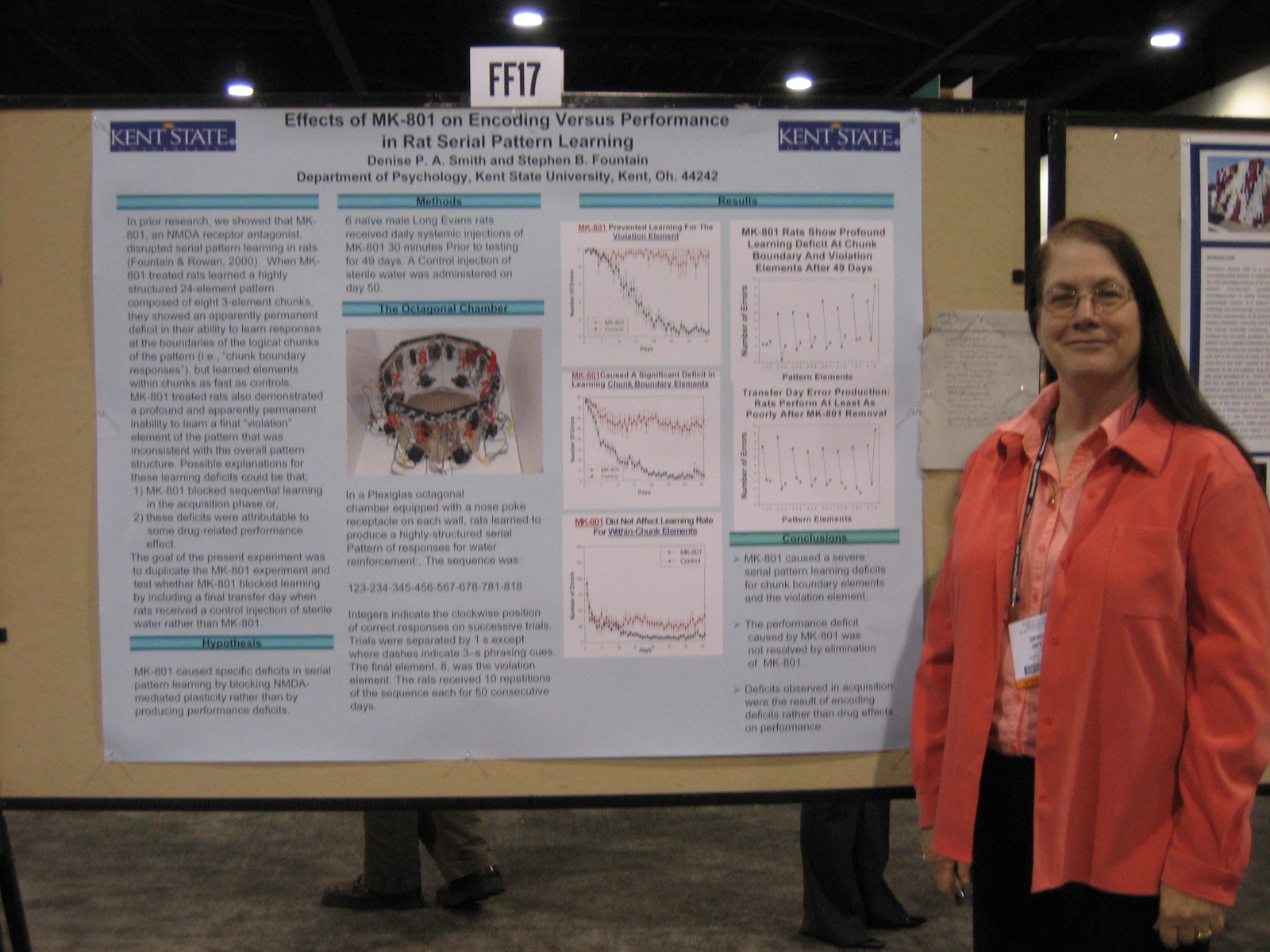| Poster Presentation Abstracts:

Differential Effects of Nicotine, Mecamylamine, and Scopolamine on Rat
Serial Pattern Retention.
PDF
A. M.
Chenoweth & S. B. Fountain, Kent State University, Kent, OH
Rats are sensitive to the structural organization of serial patterns in
sequential learning. For example, rats tend to make more errors where
structure changes (e.g., at chunk boundary and violation elements) than
at within-chunk elements in acquisition. Further, these elements are
more sensitive to manipulations, including brain lesions,
pharmacological agents, and changes to contextual and temporal cues
during acquisition and in retention. Prior evidence has suggested that
central cholinergic systems are necessary for acquiring and retaining
appropriate responses at elements in the pattern where structure
changes. We examined the effects of three cholinergic drugs on retention
peformance of serial patterns. Mecamylamine and scopolamine were chosen
to explore differential effects of antagonists on nicotinic and
muscarinic receptor sub-types, respectively, whereas nicotine was chosen
to compare the effects of an agonist to those of the antagonists on
performance. Rats learned to press levers in an octagonal operant
chamber in a particular order (the serial pattern) for brain stimulation
reward in a discrete-trial procedure with correction. All rats learned a
pattern composed of eight 3-element chunks ending with a violation
element:
123 234 345 456 567 678 781 818
where the digits represent the clock-wise positions of levers in the
chamber, spaces indicate 3-s pauses, and other intertrial intervals were
1 s. Once rats reached a criterion of less than 10% errors on any
element type, they were systematically given i.p. injections of
mecamylamine (10 mg/kg), nicotine (0.4 mg/kg), and scopolamine (0.6
mg/kg), with at least one day of criterion performance on saline
injection days between drug injection days. Muscarinic receptor blockade
by scopolamine caused severe impairments in performance at chunk
boundary elements (the first element of chunks) and the violation
element of the pattern. The nicotinic receptor antagonist mecamylamine
and agonist nicotine caused slight but nonsignificant elevations in
errors at chunk boundary and violation elements. In all drug conditions,
responses at within-chunk elements remained unaffected relative to
criterion performance on saline. These results are consistent with the
view that multiple cognitive processes are employed concurrently to
perform sequential tasks and suggest that retaining performance at
structural changes in serial patterns may be specific to muscarinic
receptors within the cholinergic system.

Effects of MK-801
on Encoding Versus Performance in Rat Serial Pattern Learning.
PDF
D. P.A. Smith & S. B.
Fountain, Kent State University, Kent, OH
MK-801 is an NMDA
receptor antagonist which has been shown to prevent learning by blocking
plasticity at NMDA receptors. In prior research, rats given daily
systemic injections of MK-801 demonstrated profound learning deficits in
a sequential learning task while control rats attained near perfect
performance at asymptote. The present experiment examined whether
MK-801 prevented learning or merely interfered with performance during
acquisition. In a sequential learning paradigm, rats were trained in a
circular array to respond to stimuli organized in a highly structured
serial pattern. An octagonal operant chamber with nosepoke receptacles
in each of the walls made up the circular array. The task required
thirsty rats to nosepoke to backlit receptacles at the correct position
in the array for water reward. The serial pattern required rats to
choose receptacles in the following order on successive trials: 123 234
345 456 567 678 781 818. The integers refer to the clockwise positions
of the nosepoke receptacles. The pattern was divided into eight
3-element “chunks” by means of temporal cues. The elements within each
chunk were called “within-chunk elements” while the first element of
each 3-element chunk was designated the “chunk boundary element.” The
final element of the pattern was designated the “violation element”
since it violated the pattern structure. Rats were given daily
injections of either saline or 0.0625 mg/kg MK-801, Control and MK-801
injected rats performed 10 patterns per day for 49 days. Prior results
were replicated: MK-801 injected rats failed to learn the correct
response for the violation element and also showed a severe deficit
learning the chunk boundary element. On Day 50, rats previously trained
under MK-801 were tested with no MK-801 (i.e., they received control
injections). Rats previously trained under MK-801 continued to show
deficits that did not differ significantly from those observed on the
last MK-801 exposure on Day 49. The results indicate that no learning
had occurred for chunk boundary elements and the violation element while
rats were under the influence of MK-801 in the acquisition phase of the
experiment.
|